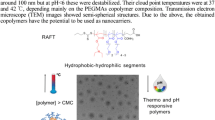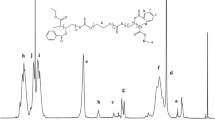Abstract
This paper describes the development of pH-sensitive poly(methyl methacrylate-acrylic acid) copolymers for the enteric coating of pharmaceutical products for oral administration. To obtain the dissolution at the desired pH level, different pH-sensitive polymers are available on the market. Usually, for each desired dissolution pH, an ad hoc polymer is designed. Thus, different dissolution pH values could ask for completely different polymers. Instead, the materials proposed in this work are copolymers of the same two monomers, and the different dissolution pH was obtained by changing the volume fraction of the hydrophobic methyl methacrylate monomer to the hydrophilic acrylic acid monomer. Increasing the volumetric percentage of methyl methacrylate causes the polymer to dissolve at increasing pH, until the dissolution does not take place at all, and it is replaced by a slow swelling phenomenon. The copolymers obtained were characterized by differential scanning calorimetry, in order to evaluate their glass transition temperature, and these latter were related to %MMA. The molecular weights of the pure polymers (PAA, PMMA) were measured by intrinsic viscosity, to further validate the glass transition temperatures observed. The dissolution of the copolymers was carefully tested in buffer solutions for a dense set of pH values. A linear relationship between dissolution pH and volumetric percentage of methyl methacrylate was obtained from these measurements. As a result, for any physiological compartment, the copolymer which dissolves at the pH of interest can be easily synthesized.





Similar content being viewed by others
References
Qiu Y, Park K (2001) Environment-sensitive hydrogels for drug delivery. Adv Drug Deliv Rev 53:321
Maharaj I, Nairn JG, Campbell JB (1984) Simple rapid method for the preparation of enteric-coated microspheres. J Pharm Sci 73:39
Brannon-Peppas L, Peppas NA (1990) Dynamic and equilibrium swelling behavior of pH sensitive hydrogels containing 2-Hydroxyethyl methacrylate. Biomaterials 11:635
Peppas NA, Klier J (1991) Controlled release using P(EG-g-MAA) hydrogels. J Control Release 16:203
Yessine MA, Lafleur M, Petereit HU, Meier C, Leroux JC (2003) Characterization of the membrane-destabilizing properties of different pH-sensitive methacrylic acid copolymers. Biophys Biochim Acta 1613:28
Abusafieh A, Gobran R, Kalidindi SR (1997) Synthesis and characterization of a poly(methyl methacrylate-acrylic acid) copolymer for bioimplant applications. J Appl Polym Sci 63:75
Brandrup J, Immergut EH, Grulke EA (1999) Polymer handbook, 4th edn. Wiley, New York
Turner DT, Schwartz A, Graper, Sugg H (1986) Highly swollen hydrogels: vinyl pyrrolidone copolymers. Polymer 27:1619
Author information
Authors and Affiliations
Corresponding author
Rights and permissions
About this article
Cite this article
Barba, A.A., Dalmoro, A., De Santis, F. et al. Synthesis and characterization of P(MMA-AA) copolymers for targeted oral drug delivery. Polym. Bull. 62, 679–688 (2009). https://doi.org/10.1007/s00289-009-0040-4
Received:
Revised:
Accepted:
Published:
Issue Date:
DOI: https://doi.org/10.1007/s00289-009-0040-4




